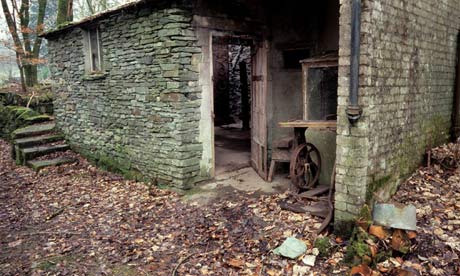Kurt Schwitters, the great dadaist of Cumbria
Kurt Schwitters, a star of the dada movement, wanted to turn this barn into 'the ultimate artwork'. Now Damien Hirst is campaigning to get it restored. By Philip Oltermann
- The Guardian, Tuesday 28 April 2009
- Article history

Panoramic exterior of the Merz Barn. Photograph: Nick May/Littoral
In the Sprengel Museum in Hanover, there is a cheekily doctored portrait of King Edward's eldest son, Prince Albert Victor. Half of his mustachioed face has been blacked out, and a razor blade has been glued across his chest in a reference to the (discredited) claims that the prince was Jack the Ripper. It looks like a piece of pop art, not unlike the Beatles' Sergeant Pepper LP, and so the date comes as a shock: 1947. A scrawl explains that this used to be a portrait of HRH, adding: "Now it is a Merz picture. Sorry!"
The prankster who wrote these words was Kurt Schwitters, one of the most innovative and eccentric artists of the 20th century. In his native Germany, there are schools and streets named after him. In Britain, where Schwitters spent his final 18 years, his legacy has been all but forgotten. Now a group of artists and academics, including Damien Hirst, Antony Gormley and Anish Kapoor, want to change that - by building a Schwitters museum in the crumbling barn near Ambleside in the Lake District where he worked.
Such a picture-postcard setting might seem an unlikely spot for a museum devoted to an artist now seen as one of the leading lights of the very urban dada movement; but Schwitters' life was anything but straightforward. Born in 1887 and brought up in Lower Saxony, he became Hanover's official typographer, establishing a bourgeois lifestyle by the time he came into contact with the more anarchic figures of the Weimar Republic's art world, such as George Grosz and Tristan Tzara.
Schwitters shared their techniques - cutting up newspapers, magazines and photographs and glueing them back together - but not their politics. His approach was also more wide-ranging, incorporating performance poetry, sculpture and architecture. A compulsive hoarder, he gradually transformed his home in Hanover into a sort of walk-in collage of detritus, incorporating paintings, abstract sculptures and found objects. The Merzbau, as Schwitters called this, grew so big that he had to ask his tenant on the floor above to move out so that he could break through the ceiling. (The term Merz was a contraction of the word Kommerz, and became a prefix for his collages.)
Schwitters fled Germany after one of his collages was included in the Nazis' exhibition of "degenerate art". He found his way to Britain, but most gallery directors refused to meet this tall eccentric with a German accent who only occasionally wore socks. To make matters worse, in 1943 Schwitters found out that his old home in Hanover, and with it the Merzbau, had been destroyed by Allied bombs. Depressed, Schwitters left London to holiday in the Lake District and never returned.
There, he earned a living painting portraits of Ambleside locals. One sitter, a retired gardener and landscape artist called Harry Pierce, offered him a disused barn as a studio. Schwitters accepted and, in 1947, began work on a new walk-in collage, christening it the Merz Barn. Pierce helped him gather ingredients: stones, pieces of glass, metal, broken picture frames, a china egg, gardening tools, all of which were to be plastered into the walls. "I am working three hours a day," Schwitters told a friend. "But I'll need three years."
In January 1948, Schwitters died of pneumonia. The Merz Barn, a one-hour walk from Wordsworth's cottage, soon became a secret pilgrimage spot for artists and academics. Damien Hirst remembers that a former teacher at Goldsmiths chanced upon it while rambling. "When they went inside," Hirst says, "it was filled with loads of old farming equipment; the windows were low down with grass growing outside, giving it an eerie green light throughout. To me, as a student, that was a very inspirational story."
In the 1960s, with the explosion of pop art, there was a renewed interest in collage. Richard Hamilton was given a grant to look into preserving the decaying Merz Barn. A whole sculpted plasterwork wall - as far as Schwitters had got in creating his "ultimate artwork" - was transported to Newcastle's Hatton Gallery. But once the work was gone, the barn was forgotten.
More than 40 years later, Ian Hunter, an artist from Northern Ireland, received a grant to buy the farm. His charity, the Littoral Arts Trust, now plans to restore the barn, install a replica of the wall (the original is now estimated to be worth £15m) and open a community gallery. It is hoped that an auction at the Royal College of Art next month will raise the necessary £500,000.
Schwitters would have enjoyed being so valued in his adopted country. "England," he once wrote to a friend, "is idyllic, romantic, more so than any other country." And he would certainly have appreciated the unlikeliness of his revival. As his gravestone in Germany says: "You never know".
• More details at merzbarn.net
